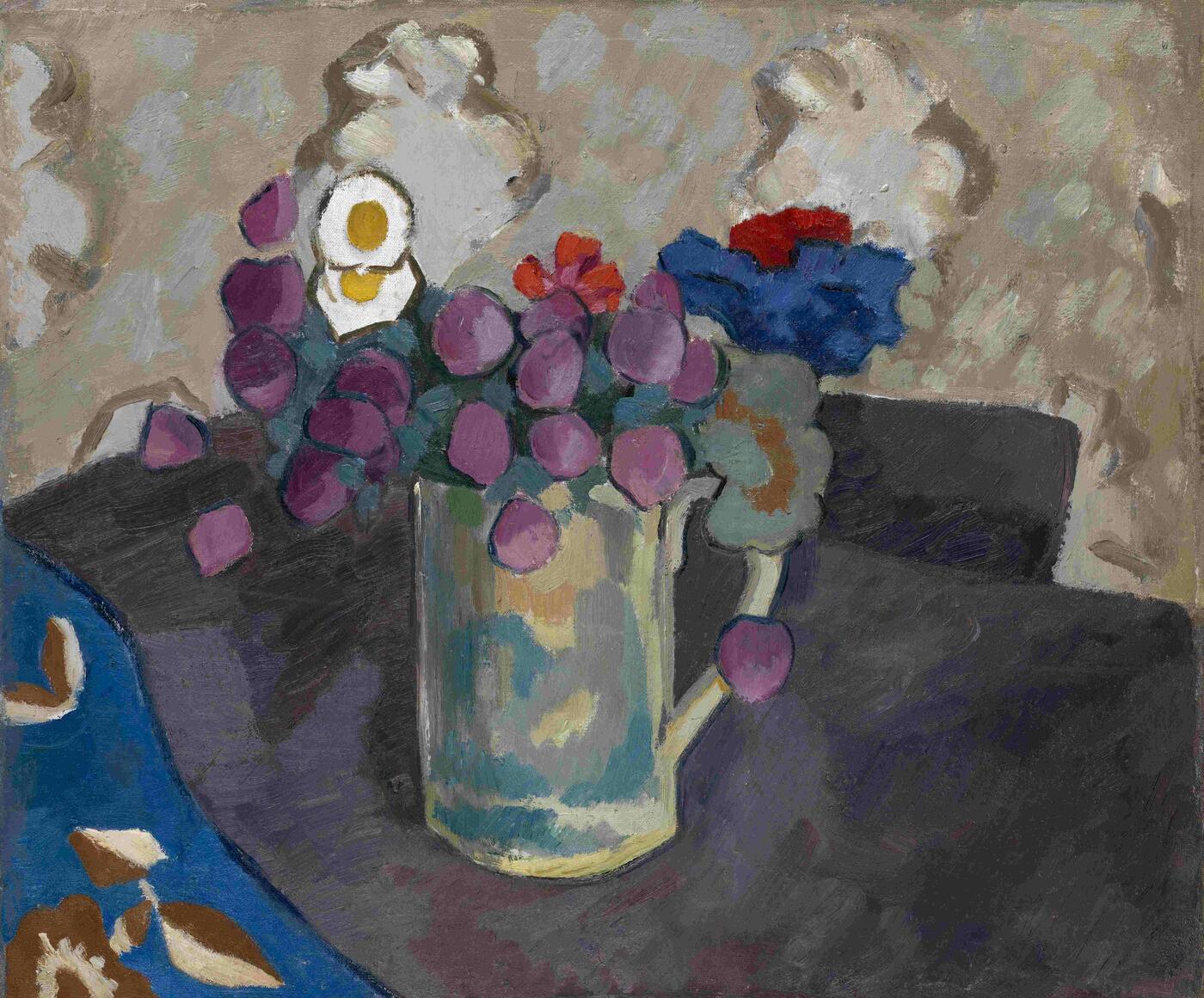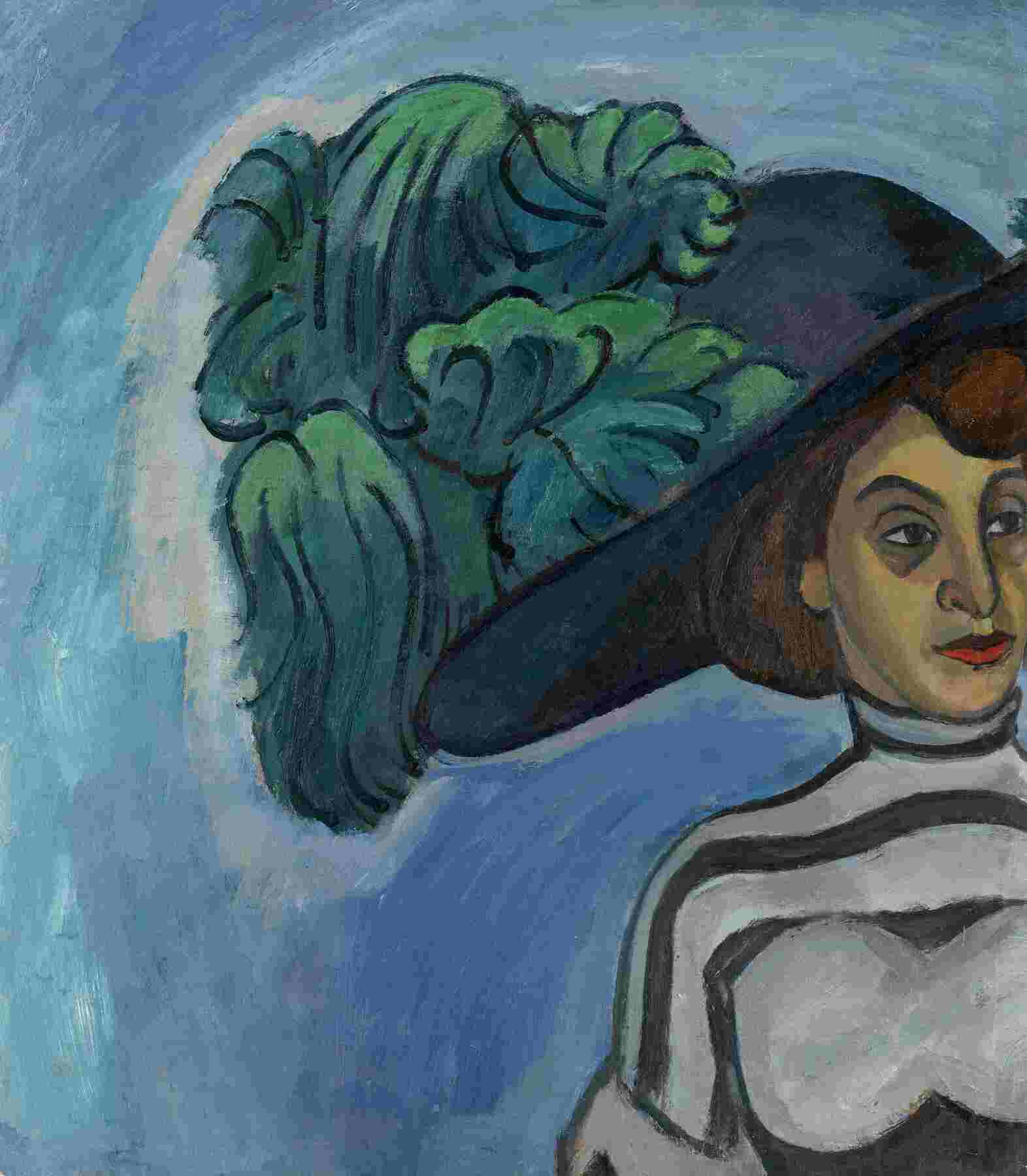MacDougall's Russian Art Auctions 1-2 Dec 2010
1 December 2010

* 349. FALK, ROBERT 1886-1958
Still Life with Clover and Lady in a Hat with Green Plumes, double-sided work c. 1910-11
Oil on canvas, 54 by 61 cm.
600,000-900,000 GBP
Authenticity has been confirmed by the experts D. Sarabianov and Yu. Didenko.
Authenticity certificate from the author of the monograph on R. Falk T. Levina.
Authenticity has been confirmed by the expert I. Geraschenko.
The work will be included in the forthcoming revised edition of the catalogue raisonne of R. Falk, prepared by Yu. Didenko and D. Sarabianov.
Robert Falk’s double-sided canvas, Still Life with Clover and a fragment of a Lady in a Hat with Green Plumes, brings together two notable works of Robert Falk’s early Jack of Diamonds period. The stylistic particularities of both these pictures — the decorative, two-dimensional handling of space, the simplification of form in conjunction with Cubo-Futurist elements, the boldly-patterned background — are indeed typical for Falk’s work of this period. From the 1900s onwards Falk frequently used the other side of the canvas for his fresh works, sometimes also cutting them into several pieces. In this case, in order to paint Still Life with Clover,/i> on the front, the artist decided to sacrifice the portrait of an unknown lady which he had painted not long before.
In the words of the recognised Falk specialist Yulia Didenko there are some stylistic traits which we can trace in Falk’s works throughout the 1910s. The simplified rendering of the flowers, the dark surace of the table and its disjointed, mobile boundaries, and the very principle of the relationship between objects and their background — these traits bear a definite stylistic correlation to the still life Paper Flowers, of 1915.
On the table surface are set out a jug with flowers and a blue, flower-patterned drape. This motif is familiar from the brightly-coloured drapery in the left-hand corner of the table in the well-known still life of 1910 in the collection of the Serpukhov Art Museum. Similar drapery also appeared in Falk’s later works, for example in the form of a curtain in Singing Bottles, 1917. In Still Life with Clover a complex colour range is worked through, from the vivid, unmitigated blue of the drape and the cornflowers which have been slipped in among the clover, via the complex interweaving of violet, brown and grey hues in the surface of the table to the jug, its shimmering water yellow and pale blue through the glass, and the raspberry-pink flower heads, set against a dull background, painted in dirty pink and pale grey tones. This treatment of a background with a bold, decorative design bears some similarity to the more brightly-patterned background of the 1911 painting Portrait of a Woman (Dina Androsova).
Yulia Didenko and Dmitri Sarabianov date Still Life with Clover between 1912 and 1915, based on the fact that the earliest known case of the artist using the back of a cut-up canvas was in 1912, when Falk painted Still Life with Large Bottle, Eggs and Beetroot on the back of a fragment of a portrait of a lady in a hat with a ficus. As well as this, all the stylistic characteristics in the painting of this canvas allow us to include it with absolute certainty among Falk’s Jack of Diamonds works.
Falk later wrote of his Jack of Diamonds style that "At that period I liked bright, contrasting juxtapositions, simplified and expressive contours which I even emphasised with a dark outline. Now it seems to me that I was at that time ridding myself of my childhood impressions of the cook’s little trunk and blanket… To some degree I was paying tribute to Cubism: many of my pieces of that time are marked by dislocations of form."
Of course, during his Jack of Diamonds period, Falk was not only painting still lifes and landscapes, but also portraits. Furthermore, as we can see from this double-sided canvas, Falk was already developing a poetics of each of these genres at the time. The fragmentary Lady in a Hat with Green Plumes is one part of a large composition and can be dated stylistically to 1911, the short-lived Primitivist period of Falk’s career. The portrait is marked by a trait typical of the early years of the Jack of Diamonds group, an orientation towards turn-of-the-century French painting, striving to establish a decorative painting method. Unfortunately, most of Falk’s portraits in this style were destroyed by the artist himself. However, in this case the right-hand section of the picture which had been cut up and thus destroyed by the artist has, by some miracle, been preserved. It turns out that the fragment of the above-mentioned composition with the lady in a hat and a ficus correlates exactly in terms of size and colour with our fragment.
A similar juxtaposition of a female figure with a house-plant is encountered in several Falk paintings of 1912, such as Wife of the Excise Official and Family of the Distiller Blinker, both painted in Ukraine at the Kulichko estate, near the town of Lebedin in Kharkov province.
Falk tried to express in his portrayal the character and status of his model by painterly and plastic means. These qualities allowed him to combine his enthusiasm for primitive art on the one hand with French painting on the other. Thanks to his general adoption of silhouetting, his strictly front-on positioning of the body, the stiffness of the pose and the intent look which Falk gives his model, this portrait is reminiscent of a provincial photograph — which is fairly typical of Jack of Diamonds portraits. The Primitivist painting style — the emphasised contour (which outlines the head in a simplified form, avoiding the complexity of the face, arms and clothes), the large, flat, coloured surfaces — all this goes to form the exaggerated, grotesque portrayal of the character. If we compare this portrait with the still life on the front, the evidence of a shared stylistic is inescapable. The principle of outlining the contours of the jug and figure, the juxtaposition of large "painted" areas — are identical. Thus, from the example of the double-sided canvas, we can plainly see how the artist, in order to achieve various artistic goals, used the methods of two-dimensional decorativism, which at that time had been adopted by the whole of Europe. It is remarkable that the project of transforming reality, so palpable in the work of all the Jack of Diamonds artists, is seen at full power in both paintings. The painting also has a very interesting provenance. It comes from the family of the well-known Voronezh artist Vasily Krivoruchko, who knew Falk personally and possibly acquired the painting from the artist himself.
Material from the expert conclusions of Dmitri Sarabianov and Yulia Didenko has been used in the description of this lot.

Notes on symbols:
* Indicates 5% Import Duty Charge applies.
Ω Indicates 20% Import Duty Charge applies.
§ Indicates Artist's Resale Right applies.
† Indicates Standard VAT scheme applies, and the rate of 20% VAT will be charged on both hammer price and premium.